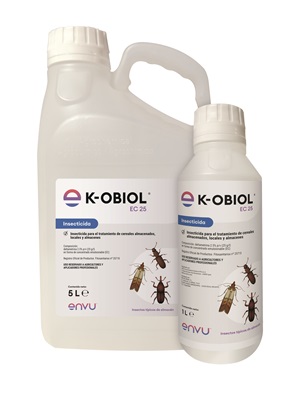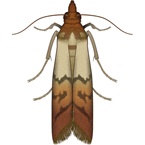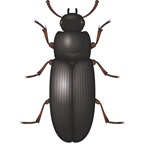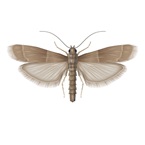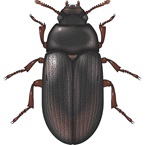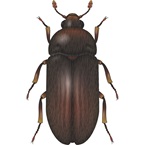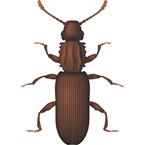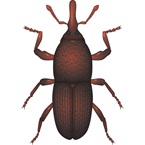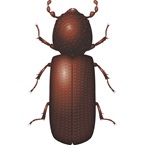Order: Coleoptera (‘sheath-wings’)
Family: Tenebrionidae
Flour Beetles:
3.5mm long
CHARACTERISTICS:
Forewings hard and leathery, meeting along midline of dorsal surface; hindwings membranous, sometimes lacking; biting mouthparts; well developed thorax; complete metamorphosis with egg, larval, pupal and adult stages. Usually 11-segmented antennae; front and middle tarsi are 5-segmented and hind tarsi 4-segmented.
SPECIES CHARACTERISTICS:
Confused Flour Beetle (Tribolium confusum)
Adult elongate, 2.6-4.4mm in length; colour, reddishbrown; antennae with loose, indistinct, 5 or 6 segmented club which may be lacking; slight ridge evident above each eye.
Rust-Red Flour Beetle (Tribolium castaneum)
Adult elongate, 2.3-4.4mm in length; colour, reddishbrown; antennae with distinct, 3-segmented club at tip; no ridge present above each eye.
AREAS WHERE FOUND:
Flour beetles are cosmopolitan. Two of the most common species are the Confused flour beetle, which is commonly encountered in bakeries and flour mills, and the Rust-red flour beetle. Both are serious pests of cereal products, including grain, flour, porridge oats and rice bran. Other products which may be attacked are oil seed, oil cake, nuts, dried fruit, spices, chocolate - even bones and other animal products. The beetles are not cold hardy, so they will only overwinter under warm conditions. They are active insects which will seek cover if disturbed and, because they are so small, can exploit the smallest crevice. They are a particular problem in
machinery where cereal and other food residues accumulate.
IMPORTANCE AS A PEST:
Flour beetles are generally recognised as secondary pests of grain and therefore increase the feeding damage done by primary pests. When present in large numbers, flour beetles will:
- Cause flour to become prone to moulding and will also turn the product grey;
- Taint commodities with secretions from scent glands.
LIFE-CYCLE:
Up to 450 eggs are laid singly at a rate of 2-10 per day, depending on temperature. The white eggs are sticky and rapidly become coated with food particles and other debris. At 22-27°C they hatch in 6-14 days. The larvae are white tinged with yellow and pass through 5-11 moults before reaching a full-grown length of 5mm. This process takes 3-9 weeks. Pupae lie naked in the same foodstuff as the larvae. They are initially white, but gradually darken in colour prior to adult emergence after 9-17 days. Adults feed on the same food as the larvae and live for 15-20 months. There may be five generations per year.
CONTROL:
Assessment of infestations
A variety of trapping techniques are available for measuring stored product beetle infestations. These include pit fall traps, bait bags, insect probe traps and adhesive traps. Whatever system is employed adequate records must be kept.
- Hygiene/management
Stores should be soundly constructed to ensure maintenance of correct storage conditions and allow for easy cleaning. They should be insulated, well ventilated and damp-proof. Cracks and crevices, which may provide harbourages for the beetles, should be kept to a minimum. Commodities should be stacked neatly above the floor level using pallets, away from walls and should not touch the ceiling. A gap between stacks will allow for ventilation, regular inspection, cleaning and, if necessary, treatment with insecticides (see recommended products). Appropriate stock rotation is important and if possible there should be a one-way passage of commodities through the premises. The careful choice of packaging can help to deter insect attack. Generally, thick, tough materials with a smooth, shiny finish are preferred. Packs should be strong and well sealed.
It is important to ensure that there are no food residues (stored commodities or secondary sources, e.g. birds’ nests) in which beetles can breed and develop to infest new materials. All infested commodities should be destroyed or fumigated. Stores should be kept scrupulously clean and farm stores should be thoroughly cleaned before harvest. All grain taken into store should be dried to a suitable moisture content (MC) and temperature e.g. <15%MC and <15°C and maintained in that condition.
- Insecticidal control:
Insecticides (see recommended products) can be applied to the fabric of stores concentrating on potential insect harbourages. Alternatively it may be appropriate to employ grain protectants.
GLOSSARY OF TERMS:
Mandible: Jaw. Tarsus (Tarsi): Apical section of leg (the foot).


